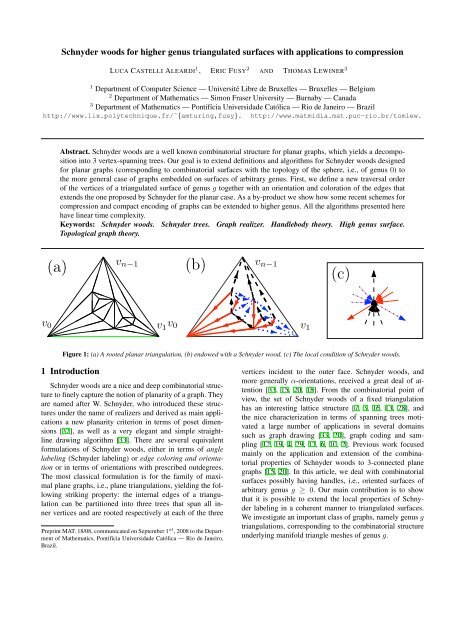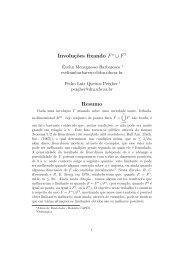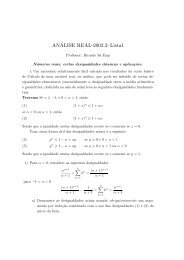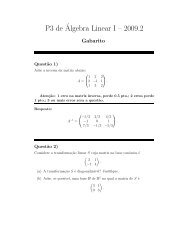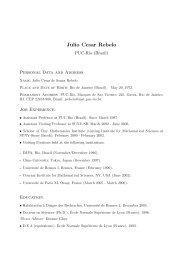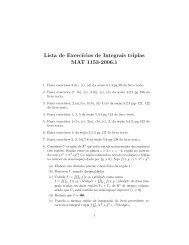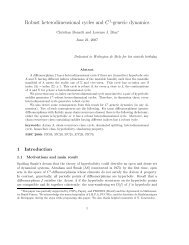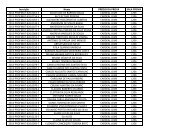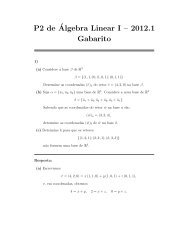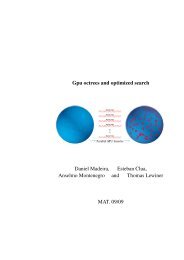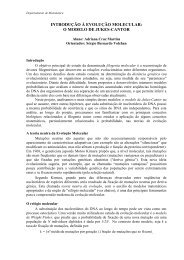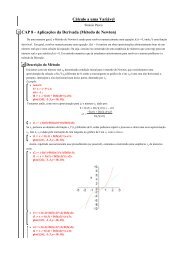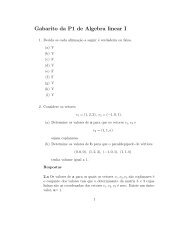Schnyder woods for higher genus triangulated surfaces with ...
Schnyder woods for higher genus triangulated surfaces with ...
Schnyder woods for higher genus triangulated surfaces with ...
You also want an ePaper? Increase the reach of your titles
YUMPU automatically turns print PDFs into web optimized ePapers that Google loves.
<strong>Schnyder</strong> <strong>woods</strong> <strong>for</strong> <strong>higher</strong> <strong>genus</strong> <strong>triangulated</strong> <strong>surfaces</strong> <strong>with</strong> applications to compression<br />
LUCA CASTELLI ALEARDI 1 , ERIC FUSY 2 AND THOMAS LEWINER 3<br />
1 Department of Computer Science — Université Libre de Bruxelles — Bruxelles — Belgium<br />
2 Department of Mathematics — Simon Fraser University — Burnaby — Canada<br />
3 Department of Mathematics — Pontifícia Universidade Católica — Rio de Janeiro — Brazil<br />
http://www.lix.polytechnique.fr/˜{amturing,fusy}. http://www.matmidia.mat.puc-rio.br/tomlew.<br />
Abstract. <strong>Schnyder</strong> <strong>woods</strong> are a well known combinatorial structure <strong>for</strong> planar graphs, which yields a decomposition<br />
into 3 vertex-spanning trees. Our goal is to extend definitions and algorithms <strong>for</strong> <strong>Schnyder</strong> <strong>woods</strong> designed<br />
<strong>for</strong> planar graphs (corresponding to combinatorial <strong>surfaces</strong> <strong>with</strong> the topology of the sphere, i.e., of <strong>genus</strong> 0) to<br />
the more general case of graphs embedded on <strong>surfaces</strong> of arbitrary <strong>genus</strong>. First, we define a new traversal order<br />
of the vertices of a <strong>triangulated</strong> surface of <strong>genus</strong> g together <strong>with</strong> an orientation and coloration of the edges that<br />
extends the one proposed by <strong>Schnyder</strong> <strong>for</strong> the planar case. As a by-product we show how some recent schemes <strong>for</strong><br />
compression and compact encoding of graphs can be extended to <strong>higher</strong> <strong>genus</strong>. All the algorithms presented here<br />
have linear time complexity.<br />
Keywords: <strong>Schnyder</strong> <strong>woods</strong>. <strong>Schnyder</strong> trees. Graph realizer. Handlebody theory. High <strong>genus</strong> surface.<br />
Topological graph theory.<br />
(a)<br />
v n−1<br />
(b)<br />
v n−1<br />
(c)<br />
v 0 v 1<br />
v 0 v 1<br />
Figure 1: (a) A rooted planar triangulation, (b) endowed <strong>with</strong> a <strong>Schnyder</strong> wood. (c) The local condition of <strong>Schnyder</strong> <strong>woods</strong>.<br />
1 Introduction<br />
<strong>Schnyder</strong> <strong>woods</strong> are a nice and deep combinatorial structure<br />
to finely capture the notion of planarity of a graph. They<br />
are named after W. <strong>Schnyder</strong>, who introduced these structures<br />
under the name of realizers and derived as main applications<br />
a new planarity criterion in terms of poset dimensions<br />
[32], as well as a very elegant and simple straightline<br />
drawing algorithm [33]. There are several equivalent<br />
<strong>for</strong>mulations of <strong>Schnyder</strong> <strong>woods</strong>, either in terms of angle<br />
labeling (<strong>Schnyder</strong> labeling) or edge coloring and orientation<br />
or in terms of orientations <strong>with</strong> prescribed outdegrees.<br />
The most classical <strong>for</strong>mulation is <strong>for</strong> the family of maximal<br />
plane graphs, i.e., plane triangulations, yielding the following<br />
striking property: the internal edges of a triangulation<br />
can be partitioned into three trees that span all inner<br />
vertices and are rooted respectively at each of the three<br />
Preprint MAT. 18/08, communicated on September 1 st , 2008 to the Department<br />
of Mathematics, Pontifícia Universidade Católica — Rio de Janeiro,<br />
Brazil.<br />
vertices incident to the outer face. <strong>Schnyder</strong> <strong>woods</strong>, and<br />
more generally α-orientations, received a great deal of attention<br />
[33, 15, 20, 18]. From the combinatorial point of<br />
view, the set of <strong>Schnyder</strong> <strong>woods</strong> of a fixed triangulation<br />
has an interesting lattice structure [7, 3, 16, 13, 28], and<br />
the nice characterization in terms of spanning trees motivated<br />
a large number of applications in several domains<br />
such as graph drawing [33, 20], graph coding and sampling<br />
[12, 19, 4, 29, 17, 6, 10, 2]. Previous work focused<br />
mainly on the application and extension of the combinatorial<br />
properties of <strong>Schnyder</strong> <strong>woods</strong> to 3-connected plane<br />
graphs [15, 20]. In this article, we deal <strong>with</strong> combinatorial<br />
<strong>surfaces</strong> possibly having handles, i.e., oriented <strong>surfaces</strong> of<br />
arbitrary <strong>genus</strong> g ≥ 0. Our main contribution is to show<br />
that it is possible to extend the local properties of <strong>Schnyder</strong><br />
labeling in a coherent manner to <strong>triangulated</strong> <strong>surfaces</strong>.<br />
We investigate an important class of graphs, namely <strong>genus</strong> g<br />
triangulations, corresponding to the combinatorial structure<br />
underlying manifold triangle meshes of <strong>genus</strong> g.


